The Secret Lives of Hoarders: True Stories of Tackling Extreme Clutter (3 page)
Read The Secret Lives of Hoarders: True Stories of Tackling Extreme Clutter Online
Authors: Matt Paxton,Phaedra Hise
Tags: #General, #United States, #Psychology, #Case Studies, #Psychopathology, #Compulsive Behavior, #Compulsive Hoarding - United States, #Compulsive Hoarding, #Obsessive-Compulsive Disorder

BOOK: The Secret Lives of Hoarders: True Stories of Tackling Extreme Clutter
12.26Mb size Format: txt, pdf, ePub
THE HOARDING SCALE
Stage 1
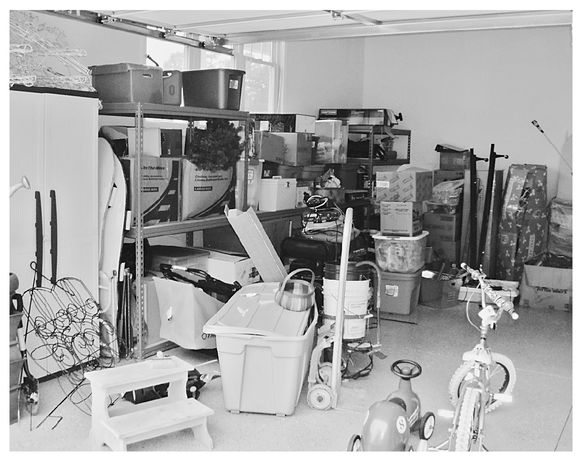
Stage 2
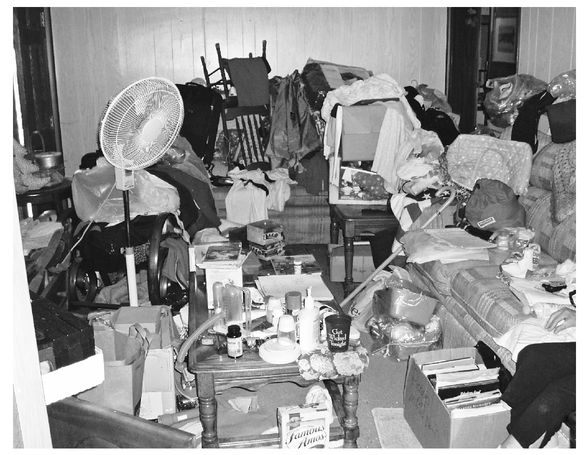
Stage 3
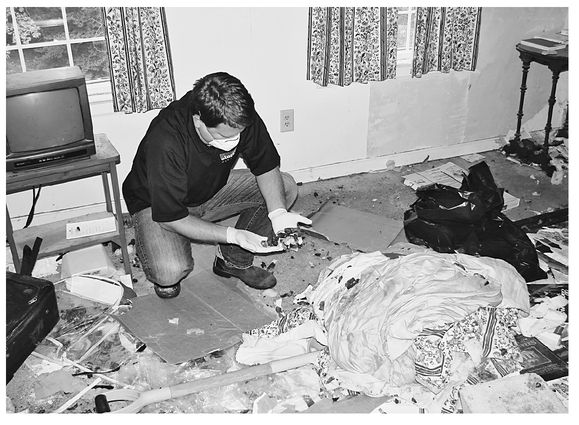
Stage 4
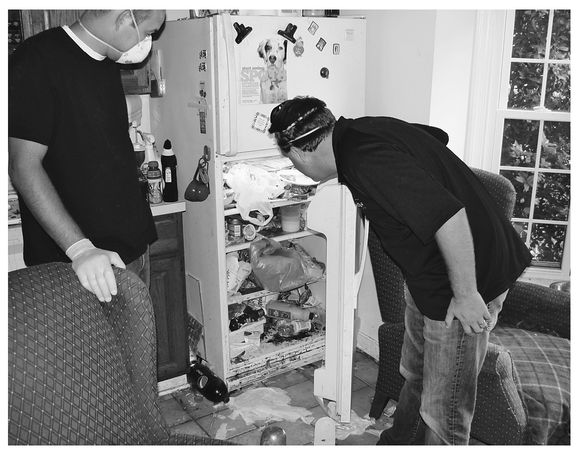
Stage 5
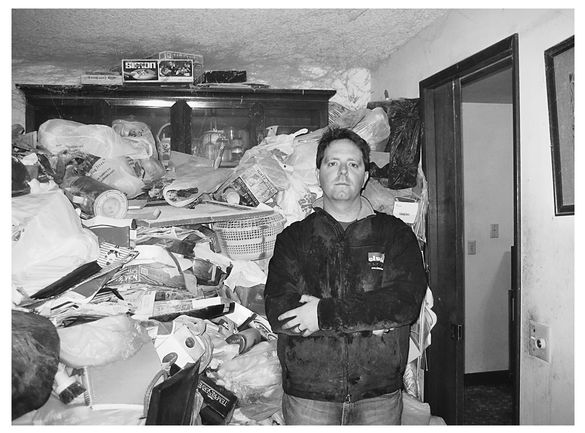
Appreciating how serious the issue isâor could beâmeans understanding where the hoarder fits on a scale from mild to totally dysfunctional. Quantifying and qualifying the problem will then help guide what actions need to be taken to aid the hoarder.
Created by the Institute for Challenging Disorganization, which is dedicated to the benefit of people affected by chronic disorganization, the Clutter Hoarding Scale is an organizational assessment tool for use by organizational professionals. It ranks hoarders from Level 1 (Brad and Ellen are the closest example discussed in this book) to Level 5 (like Margaret), depending on what's in the house and how it's being maintained.
To me, hoarding is as much about the individual as it is about the stuff. This scale does not take into the account the physical health of the individual or the person's mental state. So, as shorthand for working with hoarders, I developed my own version of this scale.
The original scale that my company, Clutter Cleaner, used was a pretty subjective one and based roughly on the number of dead cats we found in a house. But after years of working with hoarders we've refined our own language and now incorporate not only what we discover by way of stuff but also the physical and mental status of the client. As well, the Clutter Cleaner scale takes into account the social factors of American society, in which we have a lot more leisure time, and the pressure that everyoneânot just hoardersâis under to consume.
The Clutter Cleaner scale is not used by psychiatric professionals or therapists. We use it as a guideline to help understand the hoarders with whom we work and to determine how much we can realistically expect them to change.
â¶Stage 1
Brad and Ellen represent fairly typical Stage 1 hoarders. Their clutter wasn't excessive. Their house had all doors and stairways accessible. All the members of the family were healthy, clean, and well nourished, including the dog. Brad and Ellen both participated in a few hobbies, maintained their finances, and regularly invited friends and family over. Ellen felt a little anxious about the clutter, but it didn't affect their lives in a major way except for having to move piles around the house.

Brad and Ellen's garage before the cleanup. Simple Stage 1 hoarding that just needed some rules for organization.
A Stage 1 hoarder usually isn't recognizable as a hoarder. At this stage, the problem isn't about volume; it's more about the habits that the hoarder is developing as he or she tries to handle clutter. Early-stage hoarders have trouble parting with items and are beginning to build collections. They may be starting a shopping habit or a hobby that lends itself to acquiring things. The clutter will grow and hoarding will develop if these behaviors aren't curbed.
For example, Brad's computer parts could easily accumulate to the point at which they become too much to deal with. Or they could take on more emotional value than physical value, so he'd be reluctant to just toss or recycle them. Ellen risks getting behind in her general cleanupâespecially things like laundry. Clothes might become unusable and she'd have to buy moreâoften of the same thingsâjust to make do. And the more stuff one has to cope with the harder it is to keep the dust, dirt, cobwebs, and whatnot at bay.
Although messy, Brad and Ellen's house had a clean kitchen and bathrooms, and everyone in the family was still able to wash and get clean clothes daily. Brad and Ellen were apologetic about the growing mess, but they were relatively happy, without a lot of anxiety about the situation. More important, they were self-aware enough to get help at an early stage.
â¶Stage 2
Coping with stuff is like filing, before the days of the “paperless office.” You leave it for a day or two, you can cope. After a week it becomes a pain but manageable. In a month or two, you are ready to give up and stuff the whole lot under your desk. After all, if you didn't need the papers for a month or however long they sat in a pile, how important could they be anyway? And this thinkingâor inactionâis exactly what leads to Stage 2.

Typical Stage 2 family room. The furniture is starting to disappear under the stuff, but the room is still functional and pathways exist.
If Brad and Ellen hadn't sought some help early on, their house could soon have faced some safety issues, where an exit from the house is blocked, or there's one room that's basically an uninhabitable dumping ground. Everyone has a junk drawer that holds odds and ends of stuff. When that junk drawer becomes a junk room, it's a signal that you are moving up to another stage. Or if a major appliance like a dishwasher or air conditioner hasn't been working for several months because it's difficult to get to it for repair, it is most definitely a sign of a Stage 2 hoarder. And along with this, there is less attention to housekeeping: Dishes pile up in the sink and shelves remain dusty. If there are pets, there may be some odor from a dirty litter box or one too many accidents.
Hoarders at this stage are starting to focus more on clutter than on life. They tend to invite fewer people to their homes from a sense of embarrassment, which is exactly what happened to Jackson.
Jackson hoarded items having to do with the rock group Blondie. He collected every bit of memorabilia he could find with Blondie's name on it, from music to souvenirs. His house was very clean; he had his collection carefully cataloged and arranged. But it was overflowing out of the two rooms he had dedicated to be more or less the “museum.” At some point, Jackson had stopped being discriminating in his collecting and it practically drove him out of his house.
Emotionally, there is some anxiety and mild depression at this stage. A Stage 2 hoarder begins to withdraw from friends and family. As a substitute, he or she begins to acquire more things to fill that void, and the cycle continues in earnest. As the hoarder brings home more items, managing those takes priority over personal relationships. At this point, the hoarder begins to shift from embarrassment to justification, explaining why he or she “needs” the possessions.
â¶Stage 3
It is at this stage that the signs of hoarding become evident to the outside world. There may be a little structural damage to the houseâfor example, a sagging porch. Some indoor items are stored or tossed outside. There's some evidence of what I call “spaghetti” extending all around the houseâtangles of power cords and phone lines jury-rigged to keep things operating when electrical outlets are blocked off. If there are pets, there are also some carpet stains and fleas. The sink is usually filled with dishes and standing water. Walkways and stairs are overtaken with clutter and difficult to navigate. Outside storageâa garage or shedâoverflows.
Stage 3 hoarders are losing track of their personal careâbathing and haircutting aren't a priority. Because kitchens at this stage are often borderline functional, Stage 3 hoarders tend to eat food that's been cooked/reheated in the microwave oven or fast-food takeout. This almost always causes weight gain. For Stage 3 hoarders, physical activities are often limited. They'll sit for hours in front of a TV or computer screen. The bad food and lack of exercise contribute to the weight gain, and the classic stereotypical picture of the hoarder emerges. The Stage 3 hoarder's pathology is slipping into the workplace, and job performance suffers. Plus finances are probably becoming an issue.

Matt sorting through a Stage 3 animal hoarder's living room, trying to find family jewelry among the dog feces.
At this stage the hoarder is often depressed and claims to want to be left alone. Many hoarders find their best companions in their petsâand often enter into another type of hoarding. (More on animal hoarding follows.) It's likely that family members have tried to clean the house and were either rejected or withdrew, their attempts in vain.
â¶Stage 4
At Stage 4, there's structural damage to the house in several areasâfloors and ceilings may be sagging, or there is unrepaired water damage. There may also be mold, spiderwebs, and bugs. There's rotten food in the kitchen. Major appliances don't work and can't be accessed for repair. Things are stored in odd places: clothes hang from the bathtub curtain rod; important documents are in the oven. This house is truly dangerous, with blocked exits, poorly stored chemicals, and papers creating a real fire hazard.

Cracking open a refrigerator like this one, which hasn't been open in more than fifteen years, is one of Matt's and his crew's least favorite jobs.
The Stage 4 hoarder begins to retreat to a small area of livable space in the houseâa “cockpit” where the hoarder spends most of his or her time. The hoarder probably doesn't do laundry, and just buys clothes at the thrift shop to replace soiled shirts and pants. A hoarder at this stage may bathe at the sink or not at all.
Hoarders have pretty much stopped following societal rules at this stage. They struggle to get to work on time, or they may quit working and be unable to pay the bills. The phone may be ringing frequently from bill collectorsâuntil it too is shut off, along with the electricity and water. Pets are beginning to be on “vacation,” which means either dying or running away. Because their lives look so bleak, Stage 4 hoarders talk mostly about past memories or unrealistic plans for the future.
â¶Stage 5
Margaret is a Stage 5 hoarder, which is as bad as it gets. There is major structural damage to the house, with severe mold, strong odors, bugs, rodents, and cobwebs taking over. Entire floors of the house might be completely blocked off. There are walls of clothes or other items in every room. The hoarder spends the entire day struggling to complete simple tasks like eating, sleeping, and going to the bathroom. Diet is generally limited to soft drinks and either fast food or now-expired generic brand food that was bought on sale.

Other books
Under Their Skin by Margaret Peterson Haddix
Firemask: Book Two of the Last Legion Series by Chris Bunch
City of Spies by Nina Berry
Abram's Daughters 02 The Betrayal by Unknown
Battleground by Keith Douglass
Temperature Rising by Knight, Alysia S.
The Waste Land and Other Poems by T. S. Eliot
Death Where the Bad Rocks Live by C. M. Wendelboe
A Little Bit Sinful by Robyn Dehart